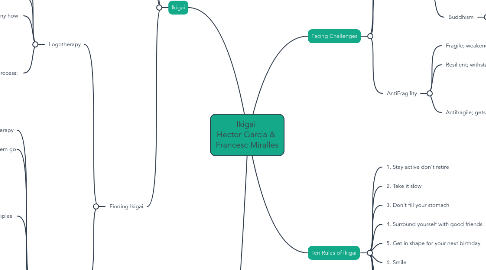
1. Ikigai
1.1. Overview
1.1.1. Japanese concept that means "a reason for being." The word "ikigai" is usually used to indicate the source of value in one's life or the things that make one's life worthwhile. The word translated to English roughly means "thing that you live for" or "the reason for which you wake up in the morning." Each individual's ikigai is personal to them and specific to their lives, values and beliefs. It reflects the inner self of an individual and expresses that faithfully, while simultaneously creating a mental state in which the individual feels at ease. Activities that allow one to feel ikigai are never forced on an individual; they are often spontaneous, and always undertaken willingly, giving the individual satisfaction and a sense of meaning to life.
1.1.2. Some people have found their ikigai; while others are still looking, though they carry it within themselves
1.1.3. Ikigai is different for all of us but one thing we all have in common is that we are all searching for meaning
1.1.4. Modern life estranges us more and more from our true nature making it very easy for us to lead lives that lack meaning
1.1.5. People who live ikigai are some of the longest lived people in the world. Tending to continue to work well past normal retirement age and despite having different eating and excise habits
1.1.5.1. Okinawa Japan
1.1.5.2. Sardinia Italy
1.1.5.3. Loma Linda California
1.1.5.4. Nicoya Peninsula Costa Rica
1.1.5.5. Ikaria Greece
1.2. Model
1.2.1. Untitled
1.3. Finding Ikigai
1.3.1. Logotherapy
1.3.1.1. Developed by Victor Frankl author of Man's Search for meaning and concentration camp survivor
1.3.1.2. Pushes patients to consciously discover their life's purpose in order to confront their neuroses
1.3.1.3. He who has a why can bear almost any how
1.3.1.4. Process:
1.3.1.4.1. 1. Person feels empy, frustrated or anxious
1.3.1.4.2. 2. The therapist shows him or her that what he is feeling is a desire to have a meaningful life
1.3.1.4.3. 3. The patient discovers his life's purpose (at that point in time)
1.3.1.4.4. 4. Of his own free will the patient decides to accept or reject that destiny
1.3.1.4.5. 5. This newfound passion for life helps him overcome obstacles and sorrows
1.3.2. Morita Therapy
1.3.2.1. Created by Shoma Morita in Japan around the same time as Logotherapy
1.3.2.2. Not meant to eliminate symptoms but instead teaches you to accept your desires, anxieties, fears, worries and let them go
1.3.2.3. Principles
1.3.2.3.1. Accept your feelings
1.3.2.3.2. Do what you should be doing
1.3.2.3.3. Discover your lifes purpose
1.3.2.4. Process
1.3.2.4.1. 1. Isolation and Rest
1.3.2.4.2. 2. Light occupational therapy
1.3.2.4.3. 3. Occupational therapy
1.3.2.4.4. 4. The return to the real world
2. Flow
2.1. Overview
2.1.1. The state in which people are so involved in an activity that nothing else seems to matter; the experience itself is so enjoyable that people will do it even at great costs, for the sheer sake of doing it - Mihaly Csikszenmihaliy
2.1.2. One key ingredient to living your ikigai is the ability to reach a state of flow and through this have an optimal experience
2.2. Seven Condition For Finding Flow
2.2.1. 1. Knowing what to do
2.2.2. 2. Knowing how to do it
2.2.3. 3. Knowing how well you are doing
2.2.4. 4. Knowing where to go
2.2.5. 5. Perceiving significant challenges
2.2.6. 6. Perceiving significant skills
2.2.7. 7. Being free from distraction
2.3. Strategies For Flow
2.3.1. Choose a difficult task (but not too difficult)
2.3.2. Have a clear concrete objective
2.3.3. Concentrate on a single task
2.3.4. Microflow: Finding joy in everyday tasks
3. Facing Challenges
3.1. Life is full of challenges; living your ikigai is going to require that you know how to not only overcome them but become stronger because of those challenges
3.2. Philosophies
3.2.1. Both of these philosophies are very different but at their roots they are methods for practicing well-being; they both aim to help practitioners control their pleasures, emotions and desires
3.2.2. Stoicism
3.2.2.1. What's the worst that could happen?
3.2.2.1.1. Reflecting on potential negative events without reacting to them
3.2.2.2. Cultivating a state of tranquility; the absence of anxiety, fear, shame, vanity, anger and the presence of positive feelings like happiness, love, serenity and gratitude
3.2.3. Buddhism
3.2.3.1. Meditation as a way to become aware of your desires and emotions and thereby freeing yourself from them
3.2.3.2. The importance of the here and now; remember that the present moment is all that you can control
3.3. AntiFragility
3.3.1. Fragile; weakened when harmed
3.3.2. Resilient; withstand harm
3.3.3. Antifragile; gets stonger when harmed
3.3.3.1. The Hydra grows two heads every time you chop off one. How can you possibly defeat something that gets stronger every time you harm it? That's anti fragility
3.3.3.2. How to become antifragile
3.3.3.2.1. 1. Create redundancies
3.3.3.2.2. 2. Bet conservatively in certain areas and take many small risks in others
3.3.3.2.3. 3. Get rid of things that make you fragile
